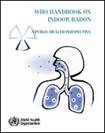Radon Recommendations for Authorities
National authorities have an important role to play in reducing radon levels.
National authorities should:
- have a reasonable understanding of indoor radon exposures across the country
- develop a national radon protection strategy
The national radon protection strategy should be straightforward and realistic, and be considered in conjunction with other public health policies, such as energy saving, non-smoking, and indoor air quality. It should address exposures in new and existing buildings, aiming to reduce:
- the overall exposure of the general population
- the highest individual exposures
To help guide action, authorities should set a national reference level for indoor radon levels:
- ICRP recommends setting a national reference level as low as reasonably achievable in the range of 100–300 Bq/m3.
- WHO guidance is basically the same: a national reference level of 100 Bq/m3 is recommended, and wherever this is not possible, the chosen level should not exceed 300 Bq/m3.
Quotes from ICRP Publications
Radon Protection Strategy: Publication 126 paragraphs 41-45
…Prevention of radon exposure is most relevant in new buildings. The implementation of preventive measures in new and renovated buildings provides a good partial solution… This also helps to develop awareness amongst professionals involved in the construction sector.
Remediation in existing buildings is also often appropriate in buildings with high radon concentrations. In such situations, there may be a primary source of radon ingress, and radon levels can often be reduced by a factor exceeding 10. … the aim should be to reduce both the overall risk for the population and, for the sake of equity, the highest individual exposures to levels that are as low as reasonably achievable…
…The radon protection strategy should be properly scaled, with other health hazards and priorities identified in the country taken into account. Furthermore, comparison and integration between the radon protection strategy and other public health policies, such as non-smoking and indoor air quality policies, should be sought in order to avoid inconsistencies and achieve better effectiveness.
Considering the ubiquity of radon exposure, and the multiplicity and diversity of situations and decision makers, a straightforward, realistic, and integrated radon protection strategy, addressing most situations with the same approach, is appropriate. It must be supported and implemented on a long-term, potentially permanent basis, and involve all the relevant stakeholders.
National reference Level: Publication 126 paragraphs 84, 76, and 86
The first step is to characterise the exposure situation of individuals and the general population in the country, as well as other relevant economic and societal criteria, and the practicability of mitigating or preventing the exposure. … Many factors such as mean radon concentration and radon distribution, number of existing homes with high radon levels, etc. should be taken into consideration.
… The Commission strongly encourages … a national derived reference level that is as low as reasonably achievable in the range of 100–300 Bqm-3…
The value of the national derived reference level for radon exposure should be reviewed periodically to ensure that it remains appropriate.




